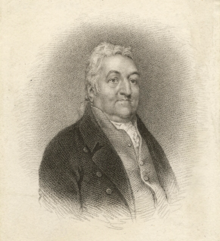John Stafford Smith (bapt. 30 March 1750 – 21 September 1836) was a British composer, church organist, and early musicologist. He was one of the first serious collectors of manuscripts of works by Johann Sebastian Bach.
John Stafford Smith | |
|---|---|
 Portrait of Smith after William Behnes, 1822 | |
| Born | Gloucester, England |
| Baptized | 30 March 1750 |
| Died | 21 September 1836 (aged 86) London, England |
| Occupations |
|
| Known for | Composed "The Anacreontic Song", later adopted as the tune of the national anthem of the United States |
Smith is best known for writing the music for "The Anacreontic Song", which became the tune for the American patriotic song "The Star-Spangled Banner" following the War of 1812, and in 1931 was adopted as the national anthem of the United States.
Early life and education edit
Smith was baptised in Gloucester Cathedral, England, on 30 March 1750, the son of Martin Smith, organist of Gloucester Cathedral from 1743 to 1782. He attended the Gloucester cathedral school, where he became a boy-singer. He furthered his career as a choir boy at the Chapel Royal, London, and also studied under Dr. William Boyce.
Career edit
By the 1770s he had gained a reputation as a composer and an organist. He was elected as a member of the select Anacreontic Society which boasted amongst its membership Samuel Johnson, James Boswell and Sir Joshua Reynolds.
In the 1770s, Smith composed music for the society's constitutional song entitled "To Anacreon in Heaven" (The Anacreontic Song). The words were by Ralph Tomlinson, the president of the society, and were inspired by the 6th-century BC Greek lyric poet, Anacreon, who wrote odes on the pleasures of love and wine. The song became popular in Britain and also America following the establishment of several Anacreontic Societies there. Smith never married.
Smith later became a Gentleman of the Chapel Royal in 1784, organist for the Chapel Royal in 1802 and Master of the Children in 1805. He also became lay-vicar of Westminster Abbey. He was organist at the Three Choirs Festival held at Gloucester in 1790. He met and worked with Joseph Haydn during the famous composers London visit.
Smith is considered to be the first Englishman to be a serious antiquarian and musicologist.[1] He began by publishing A Collection of English Song in 1779, which musicologist Nicholas Temperley called "perhaps the first scholarly edition printed in England."[2] Smith's library included the Old Hall Manuscript, Drexel 4175, as well as a copy of Ulm Gesangbuch from 1538 that had belonged to Johann Sebastian Bach.[2] He also collected works that dated back to the 12th century including some Gregorian chants. His publication Musica Antiqua (1812) included musical scores of works by Jacob Obrecht, Adrian Willaert, Jacob Clemens and Cristóbal de Morales with historical notes on each piece. According to Vincent Duckles, Smith's major contribution was "to direct the attention of his readers to the importance of source studies."[2]
Death edit
Smith died in 1836 at the age of eighty-six. He was buried at St Luke's Church, Chelsea, and has a memorial plaque in Gloucester Cathedral, above which are displayed the US and UK's flags.[3][4][5]
It is often said that Smith's death was caused by a grape-pip lodged in his windpipe.[6] According to Pliny the Elder the ancient Greek lyric poet Anacreon, after whom the Anacreontic Society is named (and hence Smith's most famous piece), died when he was choked by a grape-stone.[7]
Legacy edit
National anthem of the United States edit
In 1814, Francis Scott Key wrote the poem "Defence of Fort M'Henry" (later re-titled, "The Star-Spangled Banner") which was later set to the tune of "Anacreon", a piece composed by Smith. The US Congress officially designated this song as the US national anthem in 1931.[8]
References edit
- ^ Morrison, Chris. "John Stafford Smith". AllMusic. Retrieved 25 July 2012.
John Stafford Smith has been called 'virtually the first English musicologist.'… [He] remains a significant figure in American history as the composer of the tune that Francis Scott Key adapted into 'The Star-Spangled Banner', the national anthem of the United States.
- ^ a b c Temperley, Nicholas (2001). "Smith, John Stafford". Grove Music Online. doi:10.1093/gmo/9781561592630.article.26008. ISBN 978-1-56159-263-0. Retrieved 23 July 2020.
- ^ "Timeline of John Stafford Smith". Preceden. Retrieved 19 October 2020.
- ^ "Cathedral to ring out Star Spangled Banner in honour of its English composer". Mayflower400uk.org. Archived from the original on 24 August 2019. Retrieved 23 July 2020.
- ^ "Star Spangled Banner To Chime over Gloucester". Theamerican.co.uk. Retrieved 23 July 2020.
- ^ A Grim Almanac of Gloucestershire. Robin Brooks. ISBN 9780750956802. Retrieved 14 April 2021.
- ^ Pliny the Elder. Nat. Hist. vii.7
- ^ "John Stafford Smith: Composer of the Star Spangled Banner". Gloucestershire Portal. Archived from the original on 11 July 2007. Retrieved 25 July 2012.
Further reading edit
- Johnson, Keith. "AMG AllMusic Guide: Pop Artists: John Stafford Smith". Answers. Retrieved 25 July 2012.
- Moss, Phillip (2005). Historic Gloucester: An Illustrated Guide to the City & Its Buildings. Stroud, England: Nonsuch Publishing. ISBN 9781845880774. OCLC 318953639.
- "Material relating to John Stafford Smith (search)". Special Collections Department, University of Glasgow. Retrieved 25 July 2012.
- Lichtenwanger, William (1977). The Music of the Star-Spangled Banner - from Ludgate Hill to Capitol Hill. Washington, D.C.: Library of Congress. Retrieved 3 December 2020.
External links edit
- Works by John Stafford Smith at Project Gutenberg
- Works by or about John Stafford Smith at Internet Archive
- Free scores by John Stafford Smith at the International Music Score Library Project (IMSLP)
- Free scores by John Stafford Smith in the Choral Public Domain Library (ChoralWiki)
- Free John Stafford Smith sheet music from the Ball State University Digital Media Repository